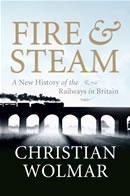 Two kinds of history are especially difficult to write. There are those whose subjects have almost no source material (biographies of Shakespeare); and there are those with so much source material it is almost impossible to know where to begin.
Two kinds of history are especially difficult to write. There are those whose subjects have almost no source material (biographies of Shakespeare); and there are those with so much source material it is almost impossible to know where to begin.
Histories of the railways fall into the latter category. The Bibliography of British Railway History alone lists 25,000 titles covering an industry less than 200 years old.
Happily, Christian Wolmar, a veteran of the transport world, has not been daunted. His aim – modestly presented, splendidly achieved – is to trace in an overarching narrative the development of the railways from the first days of steam to the arrival of the high-speed link into St Pancras in 2007.
Railways have existed, he reminds us, far longer than self-propelling locomotives: Louis XIV had a proto-railway, the Roulette, on which his courtiers amused themselves; the Swansea and Mumbles railway, from the mines to the docks, was powered not only by horses but by sail. But it was the Stockton and Darlington Railway in 1825 and then the Liverpool and Manchester Railway in 1830 that created what we know as the railway age.
Wolmar is excellent on the technical and social hurdles that impeded the development of the railways: entrenched interests were often so hostile that early railway surveyors had to operate under the cover of darkness.
But a volte-face occurred almost straight away: when the MP William Huskisson was hit by the first train to run along the Liverpool and Manchester’s line, George Stephenson turned the tragedy into a public relations coup by rushing the injured man to a doctor by rail at an unimaginable 35mph. (Huskisson died anyway.)
While ambulance-trains would not catch on until the First World War, the railways transformed every aspect of the 19th-century world. Leisure expanded: a month after the Liverpool and Manchester opened, excursion trips were already popular. Seaside towns owed their existence to the railways; hotels were built to cater for tourists travelling to areas that once only the rich could reach; golfing and fishing holidays became possible for the middle classes; race horses, transported around the country by train, raced more frequently, in front of larger crowds; the development of football depended entirely on the railways.
Even Queen Victoria was affected, buying Balmoral, 600 miles from London, only when Aberdeen was about to join the rail network.
Nothing was unchanged, be it tastes for food (fish and chip shops arrived in cities with the availability of fresh fish inland), or for suburban living (Tottenham, a working-class suburb on the edge of London, doubled in population from 1871 to 1881, and then doubled again by 1891 with the expansion of the Great Eastern line, known as the “poor man’s line” for its reasonable fares).
The Post Office used the railways from the earliest days, the penny-post and rail expanding almost in tandem. The army, too, immediately understood its possibilities: in the 1830s soldiers were sent by rail to quell Chartist uprisings.
It was in 1914, however, that the railways showed their worth in wartime: after the declaration of war in September, the British Expeditionary Forces were carried on special trains to Southampton every 12 minutes for 16 hours a day: 118,000 soldiers, 37,650 horses, 314 large guns and 1,800 bicycles were moved in a single month, without cancelling any scheduled civilian trains.
In the next four years, ambulance trains carried a further 2.7 million wounded and dying.
The rest of the 20th century is a sadder story, but Wolmar tells it with flair: the creation of the unions and the growth of industrial relations; the betrayal by the government after the railways were returned to civilian control in 1918 and again in 1945; nationalisation and the long twilight of governmental mismanagement, vested interests and departmental in-fighting, with road spending as “investment” and rail spending “subsidy”; and finally John Major’s grotesquely botched privatisation, which took taxpayer subsidy from £500 million to £5 billion a year – what Wolmar pithily refers to as “pretend capitalism”.
While all these grand themes are expertly explored and explicated, Wolmar never forgets the human dimension. He is excellent on the various personalities who created and ran the railways, including a viciously kind portrait of Beeching.
And he answers questions that anyone who takes a train in Britain must have asked: why are the first-class carriages always nearest to the barrier at a terminus? Why are the lines in Kent so much worse than anywhere else? And, most importantly for this reader, why do trains no longer say “tagadada tagadada”?
Fire and Steam solves these conundrums, and more, in a beautifully written, detailed (but never anoraky) history of two centuries of life on the iron road.
